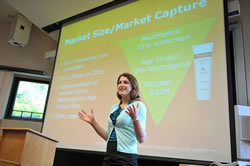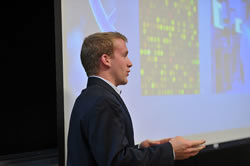
Members of Dean Greg Crawford’s Scientific Entrepreneurship course gave semester-culminating formal pitches for businesses developed from research discovery. Judges included academics and entrepreneurs with experience in presenting business plans to potential investors.
The two-hour course, which includes undergraduates in a range of majors including chemical engineering, environmental science, biological sciences, science-business, physics and mathematics, introduces students to the process of commercializing ideas and products from the laboratory.
“The course gives students a flavor of what it means to start a company,” Crawford said. “Throughout the whole semester we bring in people to speak to them,” with subjects ranging from business plans and venture capital to teambuilding and elevator pitches. “Students have to be able to communicate to the intelligent lay person. They have to be able to get people excited about it.”
The ventures included:
* TruBio Testing, Dan Cryan and Caroline Curry’s company to market a three-dimensional muscle assay to gauge the effectiveness of dietary supplements. The product, using a patented test plate for which the firm would pay royalties, is a faster, more reliable approach than current two-dimensional tests. Potential clients in an estimated $25 billion market include producers of supplements and vitamins, energy drinks and bars, drugs for growth and muscle disease, and herbal treatments. The company needs $850,000, including $750,000 for a test machine, and expects to break even within five years.
* Drops of Vision, Alexandra Brown and Lauren Krickl’s social venture to provide an eye-drop alternative to glasses and contact lenses to treat presbyopia, an age-related vision impairment. The patented drug is already approved for glaucoma treatment and should easily receive FDA approval for the new purpose. A premium on U.S. sale prices would support work to provide vision correction by the Centre for Vision in the Developing World. The founders expect to incur $400,000 in debt, including the FDA approval costs, and break even within five years. Some 1 billion people suffer from presbyopia, and the market is approaching $100 billion.

* Prognogenics, Roger Smith and Maria Font’s company to provide reliable testing that indicates whether breast cancer patients should undergo chemotherapy. Unnecessary chemotherapy is costly and unpleasant. A patent-pending algorithm by Steven Buechler, chair of the Department of Applied and Computational Mathematics and Statistics, can provide a clear evaluation of the prognosis for about one-third the cost of a more ambiguous test now on the market. The company expects to incur $1 million in debt, including FDA approval, but earn $1.5 million profit in its fifth year.
* Raypair, Matthew Anthony and Marie Forte’s company to provide nanoparticle-based technology for sunscreen that would prevent skin cancer and actually repair damaged DNA, by converting ultraviolet rays into beneficial blue light. The company expects to incur $6 million in debt in the first six years, including FDA approval, but recover in two years, in a fast-growing market expected to reach $1.1 billion by 2016. Other potential applications include cosmetics, lotions, creams, gels, and UV protection for astronauts.
* SkinSim Medical, a collaboration of Quinn Ketterman, Robert Niehaus, Zach Shary and Owen Zeng to produce far more realistic training manikins for physician training. The product uses an electronically-controlled crystalline material that can replicate thousands of diseases, with scenarios from routine to crisis. The $10,000 units are four times as expensive as current rubber simulation manikins that are less realistic and cannot be altered to simulate natural circumstances. The company hopes to collaborate with a large medical testing company that would use the technology on its manikins.
* Newline Healthcare, Jack Amato and Cameron Houk’s company to produce Quatorzilone, a drug aimed at improving the quality of life for patients who are undergoing treatment for cancer. The company would pay royalties to a German firm that has a patent pending for the drug. The founders presented a chart that showed the superior benefits of their drug to three alternatives now on the market. Cancer therapy ales are $16 billion this year and expected to reach $22.4 billion by 2020. Clinical trials of Quatorzilone could be completed in eight years, and Newline hopes to partner with a large pharmaceutical firm.